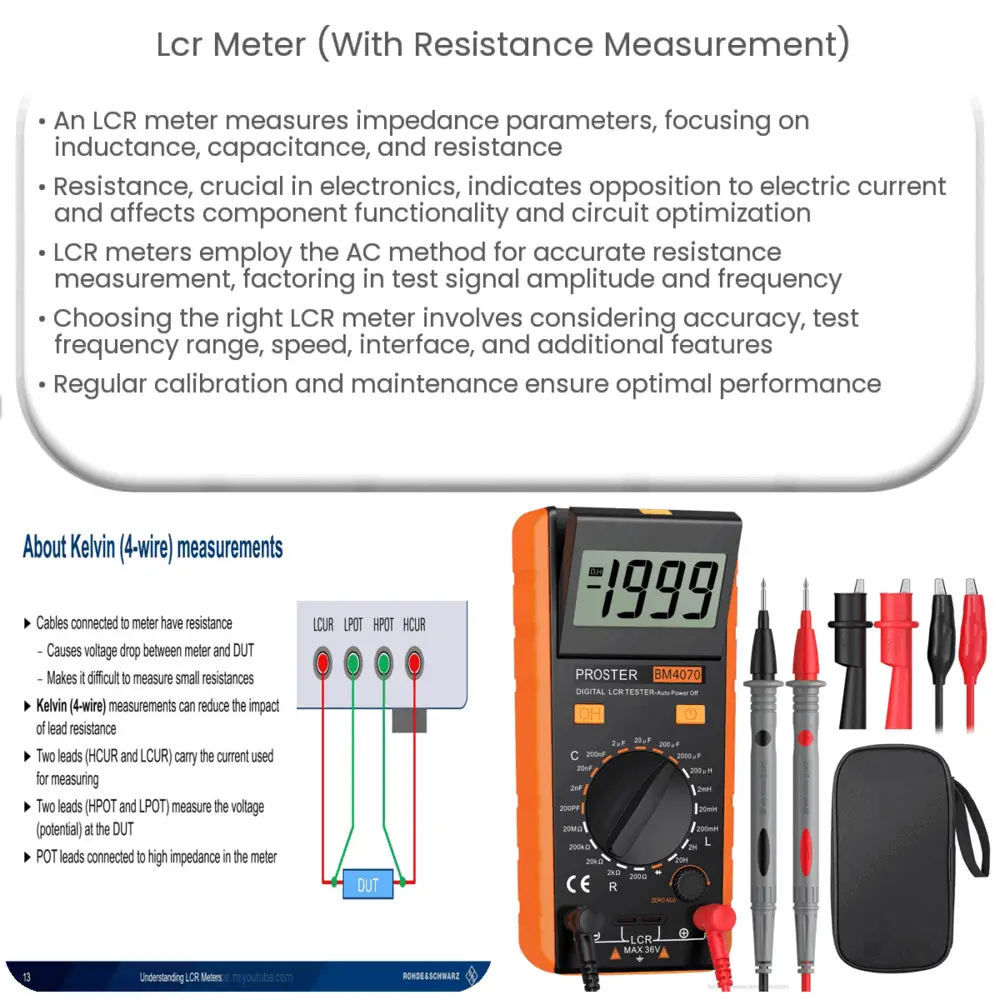An LCR meter measures inductance (L), capacitance (C), and resistance (R) of electronic components, enabling accurate impedance testing and analysis.

LCR Meter: A Comprehensive Guide to Resistance Measurement
An LCR meter is an electronic instrument used to measure the impedance parameters of a device under test, specifically inductance (L), capacitance (C), and resistance (R). These parameters are essential in determining the performance and efficiency of various electronic components and systems. In this article, we will focus on the resistance measurement aspect of an LCR meter, its significance, and how it works.
Importance of Resistance Measurement
Resistance is a crucial parameter in the world of electronics. It describes the opposition that a substance or component offers to the flow of electric current. Measuring resistance accurately is vital for various applications, such as designing circuits, testing components, and troubleshooting electronic devices. Resistance measurement helps engineers and technicians to:
- Verify the functionality and quality of resistors, ensuring they meet specifications
- Detect faulty components or connections in a circuit
- Optimize circuit performance by minimizing power loss and ensuring efficient energy conversion
- Monitor the condition of components and predict their lifespan
LCR Meter Working Principle
LCR meters measure resistance by employing the AC (alternating current) method. In contrast to the DC (direct current) method used by multimeters, the AC method eliminates the influence of contact and thermal electromotive force (EMF), resulting in more accurate and stable measurements. LCR meters work by applying a test signal to the device under test (DUT) and measuring the voltage and current response. By analyzing the relationship between the applied signal and the response, the meter calculates the resistance value.
Test Signal and Measurement Frequency
LCR meters use a sinusoidal test signal with a specific amplitude and frequency. The test frequency has a significant impact on the measurement result. Different materials and components exhibit varying resistance properties at different frequencies. Hence, selecting an appropriate test frequency is crucial for obtaining accurate and meaningful results. LCR meters typically provide a wide range of test frequencies, usually from 20 Hz to 1 MHz or even higher, allowing users to choose the most suitable frequency for their application.
Measurement Modes and Techniques
LCR meters offer various measurement modes and techniques to accommodate different types of components and applications. These include:
- Series mode: In this mode, the DUT is connected in series with the meter’s internal reference resistor. It is ideal for measuring low-resistance components or devices with high Q (quality factor) values, such as inductors and capacitors.
- Parallel mode: The DUT is connected in parallel with the reference resistor. This mode is suitable for high-resistance components and devices with low Q values.
Furthermore, LCR meters employ various techniques to enhance measurement accuracy and repeatability, such as auto-ranging, calibration, and error correction.
Conclusion
Resistance measurement is a critical aspect of LCR meters, and understanding its principles and techniques is crucial for obtaining reliable results. In the next section, we will discuss the key features and specifications of LCR meters, as well as how to select the most suitable meter for your application.
Selecting the Right LCR Meter
When choosing an LCR meter, consider the following factors to ensure you select the most suitable instrument for your specific application:
- Measurement accuracy: Ensure the LCR meter’s accuracy meets your requirements. Higher accuracy is essential for critical applications and precision components.
- Test frequency range: Choose an LCR meter with a test frequency range that matches the frequency range of your components or devices. A broader range offers more versatility.
- Measurement speed: For production testing and high-throughput applications, a fast measurement speed is crucial. Check the LCR meter’s measurement speed, usually expressed in measurements per second (mps).
- Interface and connectivity: Consider an LCR meter with user-friendly interface and compatibility with various communication interfaces, such as USB, GPIB, or LAN, for easy integration with other instruments and systems.
- Additional features: Some LCR meters include advanced features, such as built-in DC bias, temperature control, or data analysis functions, which can be beneficial for specific applications.
LCR Meter Calibration and Maintenance
Regular calibration and maintenance of your LCR meter are essential to ensure reliable and accurate measurements. Follow these tips to keep your instrument in optimal condition:
- Calibration: Perform calibration at regular intervals, as recommended by the manufacturer or based on your usage. Calibration verifies the instrument’s accuracy and corrects any deviations from the specified performance.
- Cleaning: Keep the LCR meter and its test fixtures clean to prevent contamination or damage to the device under test. Use appropriate cleaning materials and techniques, as recommended by the manufacturer.
- Storage: Store the LCR meter in a clean, dry, and temperature-controlled environment when not in use. Extreme temperatures and humidity can affect the instrument’s performance and longevity.
Applications of LCR Meters with Resistance Measurement
LCR meters with resistance measurement capabilities find widespread use in various industries and applications, including:
- Electronics manufacturing and quality control: Testing and verifying the quality of components, such as resistors, capacitors, and inductors
- Research and development: Evaluating new materials and components for use in electronic devices
- Maintenance and troubleshooting: Diagnosing faults in electronic circuits and systems
- Telecommunications: Measuring the impedance of transmission lines and antennas
- Automotive: Evaluating the performance of electronic components used in vehicles
Final Thoughts
LCR meters with resistance measurement capabilities are invaluable tools in the electronics industry, allowing for accurate and reliable impedance measurements. By understanding the working principles, techniques, and applications of these instruments, you can ensure that you select the most suitable LCR meter for your needs and obtain meaningful and accurate results.

